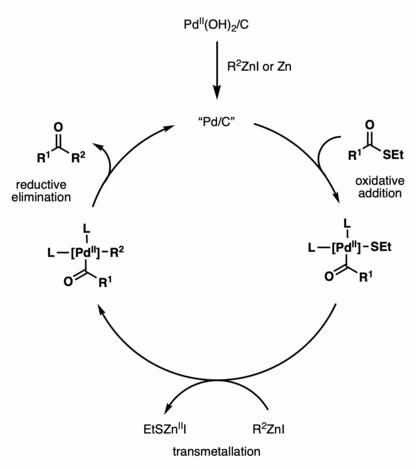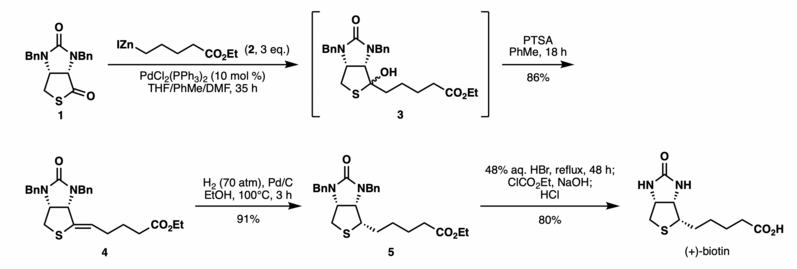Fukuyama coupling
| Fukuyama coupling | |
|---|---|
| Named after | Tohru Fukuyama |
| Reaction type | Coupling reaction |
| Identifiers | |
| Organic Chemistry Portal | fukuyama-coupling |
The Fukuyama coupling is a

Advantages
The reaction has gained considerable importance in synthetic organic chemistry due to its high
Mechanism
Although the Fukuyama cross-coupling reaction has been widely used in natural product synthesis, the reaction mechanism remains unclear. Various catalysts have been shown to promote reactivity, including Pd/C, Pd(OH)2/C, Pd(OAc)2, PdCl2, NiCl2, Ni(acac)2, etc.[2] The proposed catalytic cycle using Pd(OH)2/C (Pearlman’s catalyst) features the in situ generation of active Pd/C by reduction with a zinc reagent or zinc dust.[3] The active Pd/C species then undergoes oxidative addition with a thioester, followed by transmetallation with a zinc reagent and reductive elimination, to afford the ketone coupling product.

Reaction Conditions
Pd-catalyzed Fukuyama Coupling
Fukuyama et al. reported the PdCl2(PPh3)2-catalyzed coupling of ethyl thioesters with organozinc reagents in 1998.[4] Remarkably, α−amino ketones starting from thioester derivatives of N-protected amino acids can be synthesized without racemization in good to excellent yields (58-88%).

Ni-catalyzed Fukuyama Coupling
Aside from the use of palladium catalysts, the first nickel-catalyzed Fukuyama coupling was reported by Shimizu and Seki in 2002.[5] Ni(acac)2 was found to produce superior yields compared to other nickel catalysts.

Pd/C-catalyzed Fukuyama Coupling Employing Dialkylzinc Reagents
In 2004, the same group of researchers reported the Pd/C-catalyzed Fukuyama ketone synthesis. This reaction couples dialkylzinc reagents with various thioesters in the presence of zinc bromide, which is in situ generated from bromine and zinc dust.[6] The authors proposed that the inactive zinc bromide is shifted to the active RZnBr species via the Schlenk equilibrium. Additionally, DMF can be used as an additive to increase reaction yields.

Applications in Natural Product Total Synthesis
Biotin
The reaction has been used to shorten the synthesis of

Related Reactions
The reaction is conceptually related to Fukuyama Reduction[8] and the Fukuyama-Mitsunobu reaction.[9]
